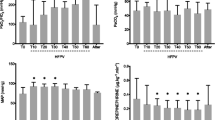Abstract
The acute effects of extracorporeal shock waves on lung morphology were studied by light microscopy in 30 New Zealand rabbits. The left kidneys of the ten animals were exposed to 2,000 shockwaves at 18 kV under anesthesia (ESWL group). Ten rabbits were in the control group; an intramuscular anesthetic agent (ketamine) and intravenous contrast media were administered to ten animals in the sham group. Localization of the left kidneys was achieved following contrast medium injection through an ear vein under fluoroscopic control. The animals were killed after the ESWL procedures and the lungs were removed. Edema, emphysema, hemorrhage, congestion, inflammation, loss of normal structure, and epithelial desquamation were determined and graded between 0 and 3 in all areas of both lungs. In order to determine whether proximity has any effect on the histopathological changes, left and right lungs were evaluated separately as well as upper and lower lobes. We found that ESWL exposed to kidney also affects all areas of the lungs in a rabbit model.




Similar content being viewed by others
References
Chaussy CH, Brendel W, Schmiedt E (1980) Extracorporeally induced destruction of kidney stones by shock waves. Lancet 2:1265–1268
Benyi L, Weizheng Z, Puyun L (1995) Protective effects of nifedipine and allopurinol on high energy shock wave induced acute changes of renal function. J Urol 153:596–598
Karalezli G, Gogus O, Beduk Y, Kokuuslu C, Sarıca K, Kutsal O (1993) Histopathologic effects of extracorporeal shock wave lithotripsy on rabbit kidney. Urol Res 21:67–70
Kaji DM, Xie HW, Hardy BE, Sherrod A, Huffman JL (1991) The effects of extracorporeal shock wave lithotripsy on renal growth, function and arterial blood pressure in an animal model. J Urol 146:544–547
Serel TA, Ozguner F, Soyupek S (2004) Prevention of shock wave-induced renal oxidative stress by melatonin: an experimental study. Urol Res 32:69–71
Weber C, Moram ME, Braun EJ, Drach GW (1991) Injury of rat renal vessels following extracorporeal shock wave treatment. J Urol 147:476–481
Ilnyckyj A, Hosking DH, Pettigrew NM, Bernstein CN (1999) Extra-corporeal shock wave lithotripsy causing colonic injury. Dig Dis Sci 44:2485–2487
Tiede JM, Lumpkin EN, Wass CT, Long TR (2003) Hemoptysis following extracorporeal shock wave lithotripsy: a case of lithotripsy-induced pulmonary contusion in a pediatric patient. J Clin Anesth 15:530–533
Malhotra V, Gomillion MC, Artusio JF (1989) Hemoptysis in a child during extracorporeal shock wave lithotripsy. Anesth Analg 69:526–528
Malhotra V, Rosen RJ, Slepian RL (1991) Life-threatening hypoxemia after lithotripsy in an adult due to shock-wave-induced pulmonary contusion. Anesthesiology 75:529–531
Hassan I, Zietlow SP (2002) Acute pancreatitis after extracorporeal shock wave lithotripsy for a renal calculus. Urology 60:1111–1113
Hung SY, Chen HM, Jan YY, Chen MF (2000) Common bile duct and pancreatic injury after extracorporeal shock wave lithotripsy for renal stone. Hepatogastroenterology 47:1162–1163
Geh JL, Curley P, Mayfield MP, Price JJ (1997) Small bowel perforation after extracorporeal shock wave lithotripsy. Br J Urol 79:648–649
Castillon I, Frievro O, Gonzales-Enguita C, Vela-Navarrete R (1999) Colonic perforation after extracorporeal shock wave lithotripsy. BJU Int 83:720–721
Gugulakis Ag, Matsagas MI, Liapis CD, Vasdekis SN, Sechas MN (1998) Rupture of the abdominal aorta following extracorporeal shock-wave lithotripsy. Eur J Surg 164:233–235
Bex A, Goepel M, Mollhoff S (1992) Extensive retroperitoneal hematoma following extracorporeal shock wave lithotripsy with second generation lithotripter. Urol Int 48:111–114
Newmark JR, Wong MYC and Lingeman JE (1996) Complications. In: Smith AD (ed) Smith’s Textbook of Endourology. Quality Medical Publishing, St. Louis, pp 681–693
Shukla AR, Hoover DL, Homsy YL, Perlman S, Schurman S, Reisman EM (2001) Urolithiasis in the low birth weight infant: the role and the efficacy of extracorporeal shock wave lithotripsy. J Urol 165:2320–2323
Chaussy CG (1982) Extracorporeal shock wave lithotripsy: new aspects in the treatment of kidney stone disease. Karger, Munich, pp 24–35
Delius M, Enders G, Heine G, Stark J, Remberger K, brendel W (1987) Biological effects of shock waves: lung hemorrhage by shock waves in dogs-pressure dependence. Ultrasound Med Biol 13:61–67
Chaussy C, Schmiedt E, Jocham D et al (1982) Extracorporeal shock wave lithotripsy. Karger, Basel, pp 1–112
Sigman M, Laudone VP, Jenkins AD, Howards SS, Riehle R Jr, Keating MA, Walker RD (1987) Initial experience with extracorporeal shock wave lithotripsy in children. J Urol 138:839–841
Sturtevant B (1996) Shock wave physics of lithotripters. In: Smith AD, Badlani GH, Bagley DH et al eds) Smith’s textbook of endourology. Quality Medical Publishing, St Louis, pp 529–552
Berger JJ, Boysen PG, Gravenstein JS, Banner MJ, Carlson CA (1987) Failure of high frequency jet ventilation to ventilate patients adequately during extracorporeal shock-wave lithotripsy. Anesth Analg 66:262–263
Zeitling GL, Roth RA (1988) Effect of three anesthetic techniques on the success of extracorporeal shock wave lithotripsy in nephrolithiasis. Anesthesiology 68:272–276
Author information
Authors and Affiliations
Corresponding author
Rights and permissions
About this article
Cite this article
Eroglu, M., Cimentepe, E., Demirag, F. et al. The effects of shock waves on lung tissue in acute period: an in vivo study. Urol Res 35, 155–160 (2007). https://doi.org/10.1007/s00240-007-0092-6
Received:
Accepted:
Published:
Issue Date:
DOI: https://doi.org/10.1007/s00240-007-0092-6




